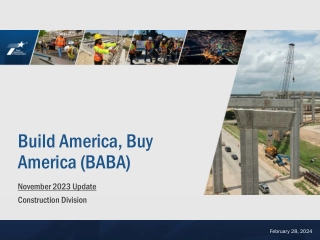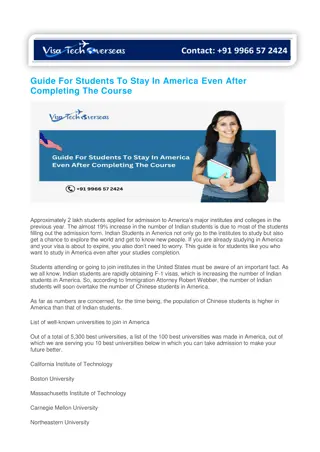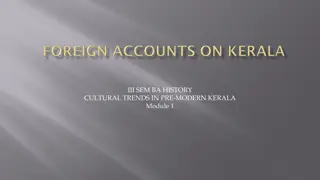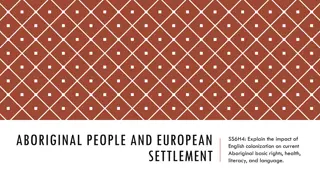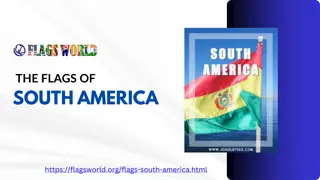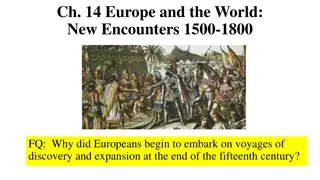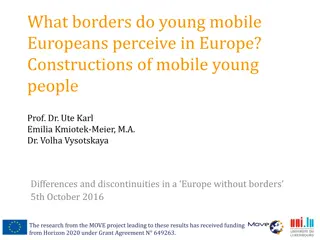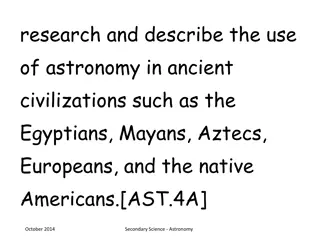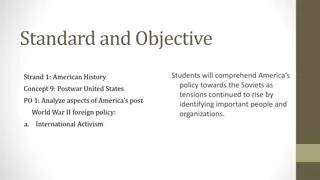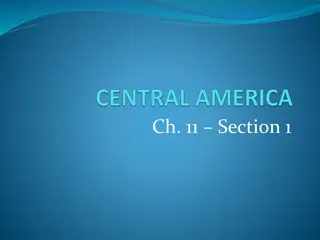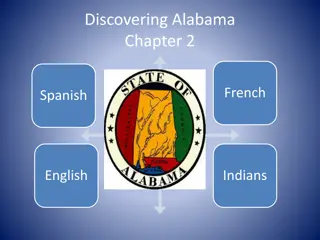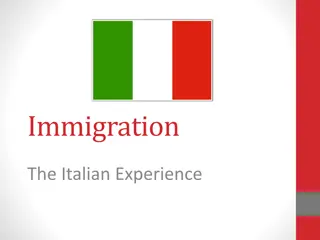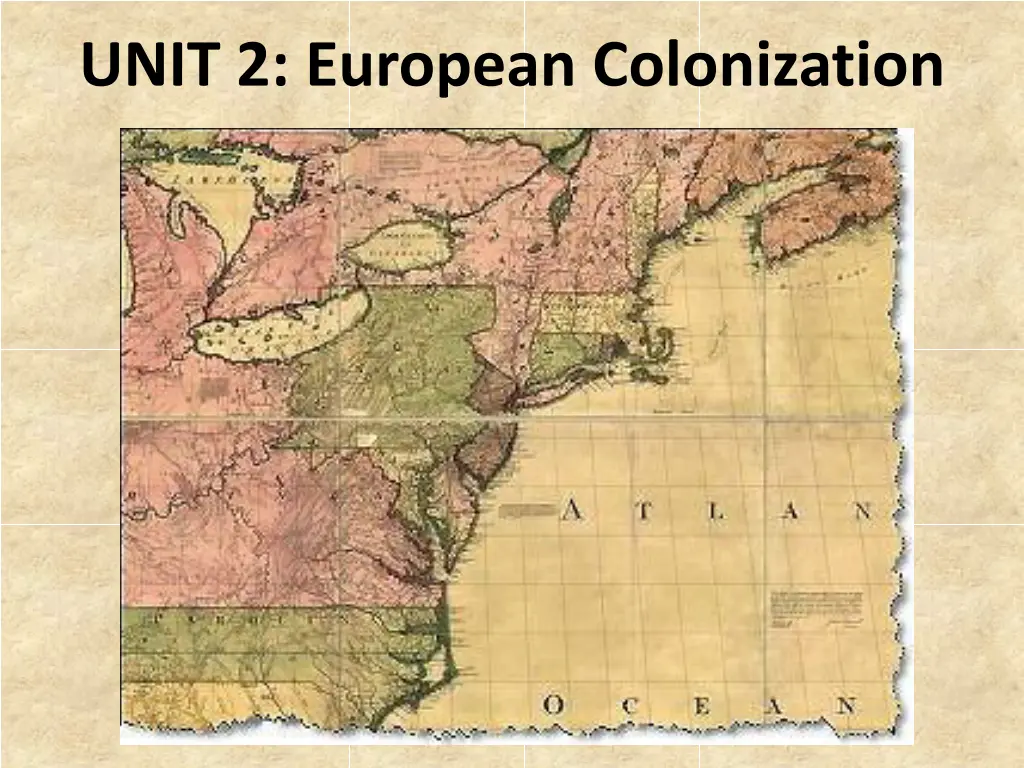
Exploration and Colonization: European Influence on the Americas
Discover how European nations explored and colonized the Americas, driven by factors like mercantilism, religious conflict, and the pursuit of the Three Gs (Gold, Glory, God). Learn about the colonization efforts of Spain, France, and England, shaping the history of the American continents.
Uploaded on | 0 Views
Download Presentation

Please find below an Image/Link to download the presentation.
The content on the website is provided AS IS for your information and personal use only. It may not be sold, licensed, or shared on other websites without obtaining consent from the author. If you encounter any issues during the download, it is possible that the publisher has removed the file from their server.
You are allowed to download the files provided on this website for personal or commercial use, subject to the condition that they are used lawfully. All files are the property of their respective owners.
The content on the website is provided AS IS for your information and personal use only. It may not be sold, licensed, or shared on other websites without obtaining consent from the author.
E N D
Presentation Transcript
A long time (about 500 years) ago on a continent far, far away Renaissance brought new discoveries in shipbuilding, navigation, and mapmaking European countries began sailing oceans to find new trade routes to Asia Columbus discovery of the Americas led to race to establish colonies
Why Did They Want Colonies? Mercantilism: trade wealth = national power Countries needed natural resources to sell or manufacture into trade goods Colonies a source of raw materials (GOLD?!)
Meanwhile, back in Europe RELIGIOUS WARFARE! Newly Protestant countries (ex. England) feuding with Catholic countries (ex. Spain) over which Christianity is the right one Minority religious groups faced persecution (even death!) Most land owned by nobles or church lack of economic opportunity for commoners
The Three Gs of European Exploration GOLD Make money GLORY--Military heroes GOD Religious Freedom OR spread Christianity to Native Americans
Who Colonized America? SPAIN (you learned about them in TX History): Explored southern part of North America Conquered and enslaved Natives in South and Central America and American Southwest Built missions, established farms, but few large settlements wanted to make Natives into Spanish citizens
FRANCE: Explored and claimed Mississippi Valley and central U.S. named Louisiana after King Louis XIV Claimed eastern Canada Few settlers mostly wanted to find gold, trap furs and trade Established several important trade centers Montreal, Quebec, and New Orleans
and finally ENGLAND Settled eastern North America along Atlantic coast; competed with French for Canada Brought many settlers with families established towns, ports, and farming communities Not as concerned with missionary work saw Natives as a threat to expansion
Unit 2 BIG IDEAS 1. English settlers came to America hoping to find economic opportunity and religious freedom they couldn t have in Europe 2. Settlers endured many hardships such as disease, hunger, and Native conflicts before achieving successful colonies 3. English tradition, Protestant religion, and the distance from home led to representative governments in the colonies
VIRGINIA: The 1stEnglish Colony Establishing colonies expensive ships, men, tools, and supplies needed for success Joint stock company investors buy stock in company, then share in profits or lose money Virginia Company founded to find investors for new colony in North America Charter - legal permission from a monarch (king or queen) to establish a colony settlers have same rights as citizens at home
1607 - Jamestown Named after King James I Chose deep water port on James River easy to defend from rival explorers but Settlement on swampy land with bad water Mosquitos, disease, and poor land for farming
First Settlers First group 104 men (women came later) Gentlemen wealthy English and their servants - not used to work Indentured servants poor men who sold their labor for passage to Virginia Arrived in May - too late to plant spring crops Poor leadership - more concerned with finding gold than survival Over half die in first year
Captain John Smith 27 year old adventurer, arrived in 1608 Captured by Powhattan (Algonquin chief) Pocahontas saved his life Took leadership role in Jamestown He who doesn t work - doesn t eat
Starving Time John Smith wounded in 1609, returned to England Poor leadership, conflicts with Natives left Jamestown unprepared for winter Only 60 of 214 settlers survived ate whatever they could (even cannibalism), used buildings for firewood settlement near failure Governor De la Warr arrived in 1610 with supplies and skilled builders colony survived!
Tobacco Saves Jamestown Jamestown losing money investors angry! 1609 John Rolfe brought Spanish tobacco seeds from West Indies grew well in Virginia soil and climate 1612 introduced tobacco to Jamestown after it proved successful Tobacco popular in Europe Jamestown now had profitable crop
Pocahontas Marries Royal weddings used in Europe to make peace between countries, so 1614 John Rolfe married Pocahontas, daughter of Chief Powhatan Short period of peace followed
1619 - House of Burgesses Colonists wanting more independence from Virginia Company rule Established House of Burgesses members (burgesses) elected by male land owners to make laws for the colony First representative government in colonies
First Africans Arrive Also in 1619, the first Africans arrived in Jamestown as laborers First more like servants than slaves, but true slavery of Africans would become a major part of Virginia s plantation economy
The Peace Ends Settlers continued expansion on Native land Chief Powhatan died, and new chief attacked Jamestown in 1622 - 347 settlers killed King revoked the Virginia Company s charter and made Virginia a Royal Colony Fighting would continue on the frontier until 1645 Natives forced to cede (give away) land and recognize the authority of the King.

